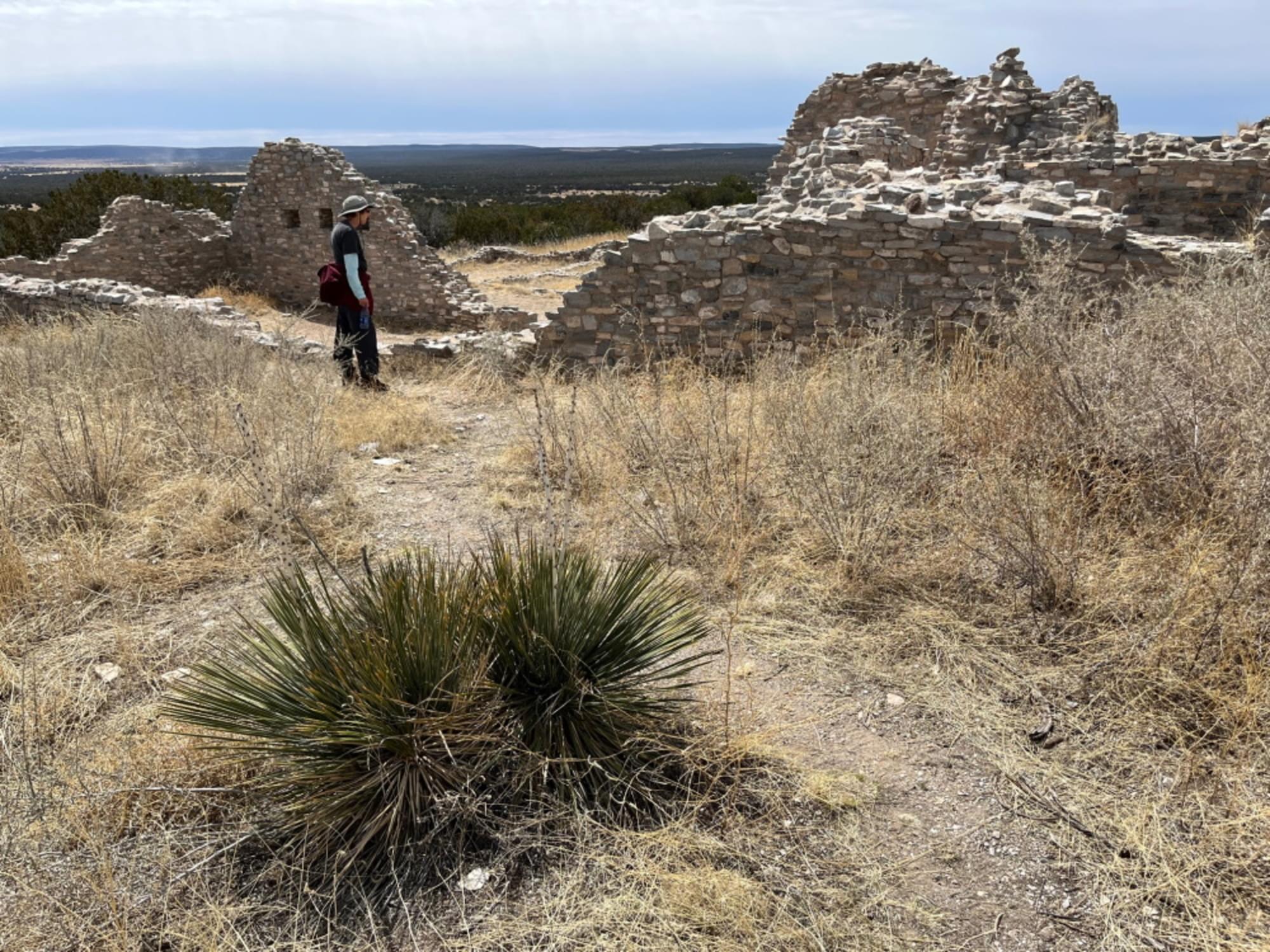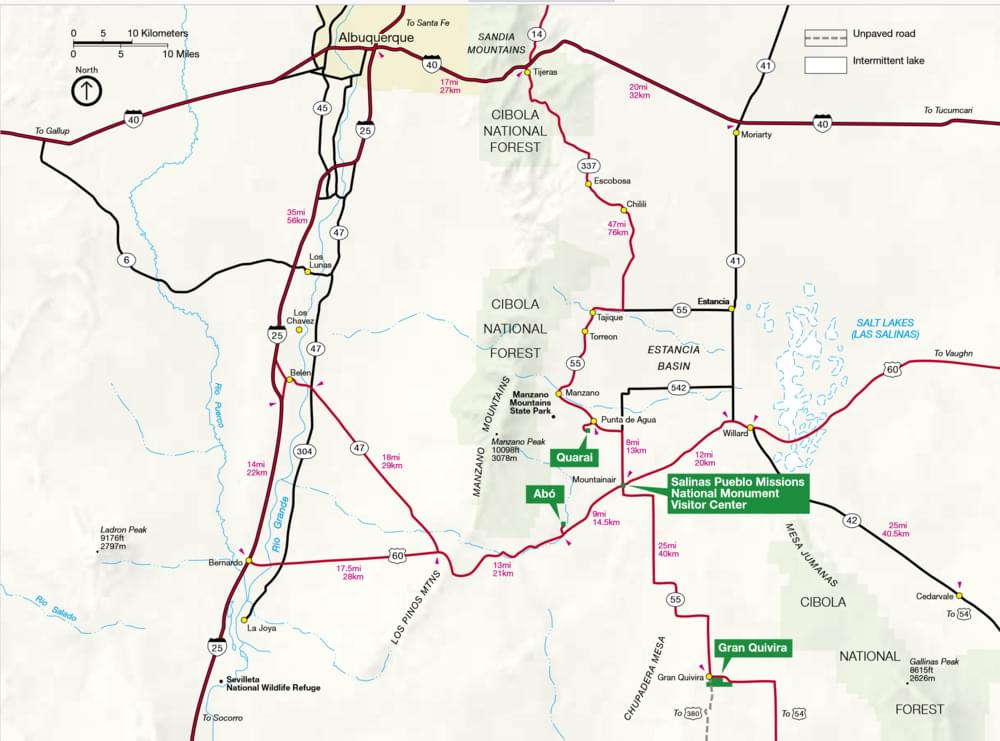Salinas Pueblo Missions NM--Gran Quivira

Salinas Pueblo Missions NM--Gran Quivira
Mountainair, New Mexico 87036
Official WebsiteSalinas Pueblo Missions National Monument map
Salinas Pueblo Missions National Monument Official Website
Salinas Pueblo Missions National Monument map
Tips for Birding
This hotspot comprises the grounds of the Gran Quivira unit of the Salinas Pueblo Missions National Monument, though eBirders have perhaps listed sightings as much as 4.5 miles north of the entrance, where there are livestock pens and a collection of ranch buildings bordering NM-55. American Kestrel perched on utility wires along NM-55 are not an uncommon sight.
Having reached the monument parking and picnic area, it is worth taking a moment to listen for calls in the nearby juniper woodland and savanna. As you make your way to the Visitor Center, you pass through native shrubland, from which it is evident Gran Quivira is definitely drier than the other two Salinas Missions, Abó and Quarai. Northeast, beyond the Visitor Center, the loop trail around the ruins is wheelchair-accessible. Vegetation in this area is dominated by non-native weeds, with the occasional hardy yucca. Before exiting the monument grounds, birders may also want to walk down the paved entrance road to the driveway of the wooded maintenance and staff housing area; for your safety and for the privacy of National Park Service personnel, please do not enter this area. Note that though the Visitor Center may be closed, the adjoining restrooms are typically open during daylight hours.
About this Location
The Gran Quivira unit of Salinas Pueblo Missions National Monument is the largest of the three units at 611 acres. Prior to Spanish contact, Gran Quivira was a vast city with multiple pueblos and kivas. Mound 7, a 226 room structure from the Pueblo IV period (A.D.1275/1300-1600), is the largest and only fully excavated pueblo at the site. During the excavation, an older Circular Pueblo was discovered under Mound 7. First contact with the Spanish probably happened in 1583 with the arrival of Don Antonio de Espejo who mentions a settlement that sounds very similar to Gran Quivira. The Spanish returned in 1598 with the expedition of Don Juan de Oñate who was the first Spaniard to colonize what would become New Mexico. Oñate visited a pueblo he called Las Humanas which was the southernmost settlement.
As part of the mission system, Las Humanas (Gran Quivira) was first placed under the Pecos Mission District. Later, with the arrival of Fray Alonso de Benavides in 1626, Gran Quivira was given more attention and later became a visita (a satellite mission without a resident Father) of Abó in 1629. That same year construction began on the first permanent mission at Gran Quivira. Under the supervision of Fray Francisco Letrado, rooms on the west end of Mound 7 (Letrado’s Convento) were used by the Spanish for housing and probably an early chapel. Letrado was moved to the Zuni Pueblo in 1631 and Gran Quivira came under the control of Fray Francisco de Acevedo at the Abó Mission. Construction on Iglesia de San Isidro was completed in 1635. In 1659 Fray Diego de Santander was permanently assigned to Gran Quivira. Soon after, construction on a new larger church, San Buenaventura, began. By 1672 a combination of disease, drought, famine, and Apache raiding led to the abandonment of Gran Quivira.
This site, sitting atop Chupadera Mesa, has magnificent views into the Estancia Valley below, but, without even a trace of water, is limited to the typical birds associated with a near-pristine juniper-savannah landscape. During the breeding season, these would include the Mourning Dove, Ash-throated Flycatcher, Western Scrub-Jay, Bewick’s Wren, Juniper Titmouse, Chipping Sparrow, Spotted Towhee, Rock Wren, Say’s Phoebe, and the occasional Gray Flycatcher.
About Salinas Pueblo Missions National Monument
See all hotspots at Salinas Pueblo Missions National Monument
Tucked away in the middle of New Mexico you’ll find the Salinas Pueblo Missions National Monument. Its three distinct sites offer a glimpse into a unique time in history—a time entrenched with cultural borrowing, conflict, and struggles. These sites continue to stand as reminders of the Spanish and Pueblo peoples’ early encounters and prompt exploration of today’s interactions among different people.
For hundreds of years, the Missions, Pueblos, Kivas, and Homesteads of Salinas Pueblo Missions National Monument have stood as testaments to the people and cultures that have called this area home. From the prehistoric Ancestral Puebloan and Jumano groups to the 17th century Spanish Franciscan missionaries, the returning settlers of the 1800s, and the 19th and 20th-century archaeologists and Park Service employees, the People, Places, and Stories of the Salinas Pueblo Missions make this a special place.
By National Park standards Salinas has modest dimensions, scarcely exceeding 1000 acres, and even these are not contiguous, but split into three units spaced as far as 35 miles apart. And yet, while considerable diversity of birds and habitats might have been expected in such a scattershot park, the homogeneity of habitat in this piñon/juniper life zone is a decidedly unifying factor, which allows the Salinas bird list to be broadly applicable to all three units. Still, each of the units (Gran Quivira, Quarai, and Abó) has its distinctive signature, dependent in large measure on the availability of wetland resources. Amazingly, in seven short years (1996-2002) more than 150 bird species were documented for Salinas. And if you’re looking for birds, Quarai is the place to find them.
Content from Official Website, Salinas Pueblo Missions National Monument Official Website, and John Montgomery
